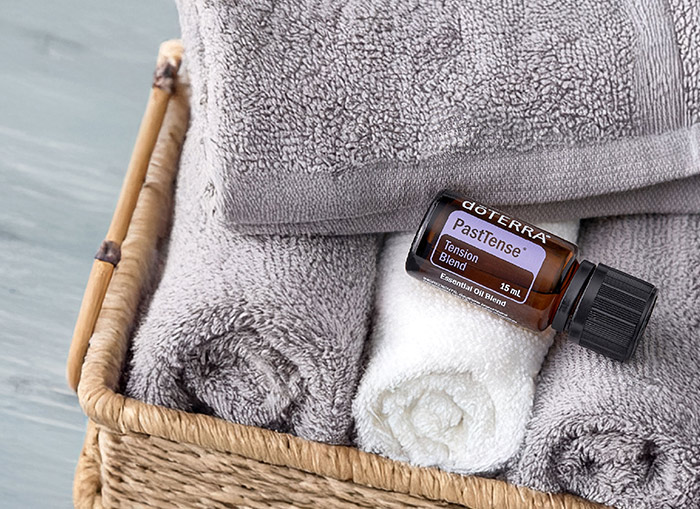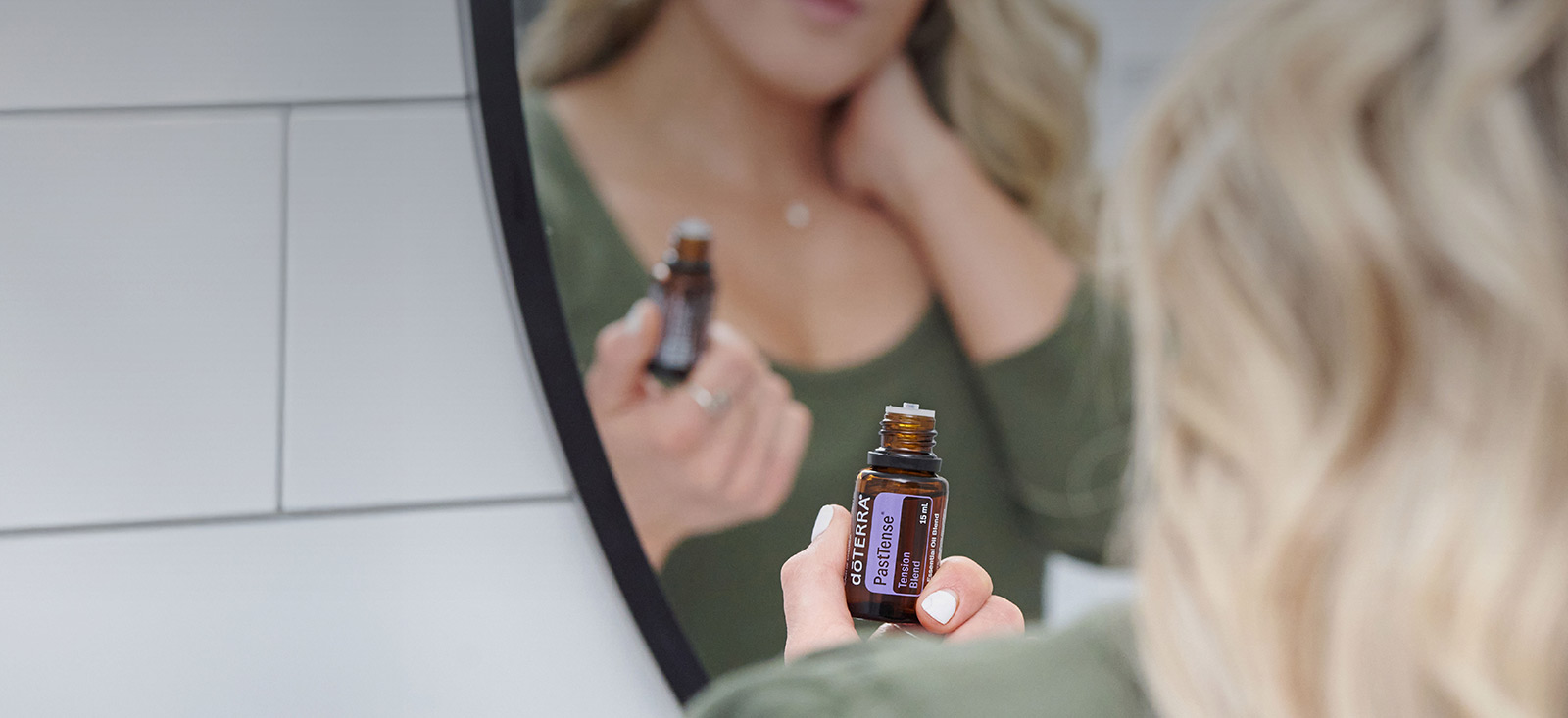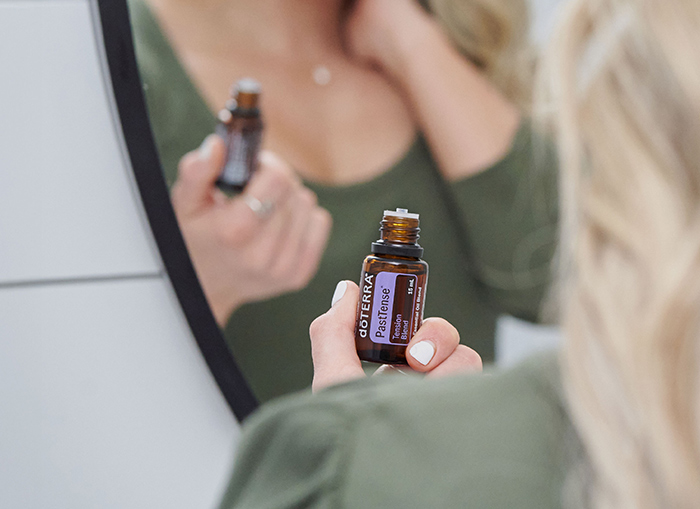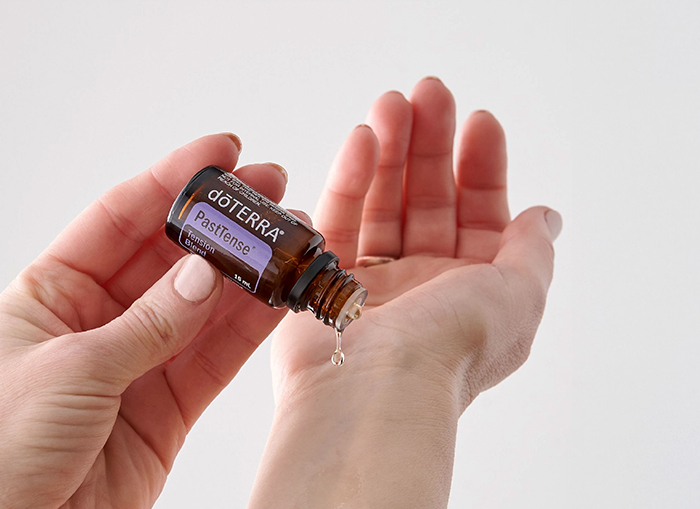
Primary Benefits
- PastTense essential oil blend provides a calming and comforting aroma.
- PastTense oil blend soothes and cools the skin.
dōTERRA[doh-teh-ruh]
Origin: a Latin derivative
meaning "Gift of the Earth."


Share

Whether you’re worried about an upcoming test or a first date, PastTense® Tension Blend creates a space to help you stay centered and grounded. With Wintergreen, Lavender, Peppermint, Frankincense, Cilantro, Marjoram, Roman Chamomile, Basil, and Rosemary essential oils, this fresh and minty blend has a profoundly powerful soothing effect.
PastTense essential oil blend has an aroma that’s relaxing and tranquil. Apply it to the neck, shoulders, and behind the ears and then breathe in the cooling, comforting scent.



Whether you’re worried about an upcoming test or a first date, PastTense® Tension Blend creates a space to help you stay centered and grounded. With Wintergreen, Lavender, Peppermint, Frankincense, Cilantro, Marjoram, Roman Chamomile, Basil, and Rosemary essential oils, this fresh and minty blend has a profoundly powerful soothing effect.
PastTense essential oil blend has an aroma that’s relaxing and tranquil. Apply it to the neck, shoulders, and behind the ears and then breathe in the cooling, comforting scent.






Wintergreen essential oil is derived from the leaves of a creeping shrub that’s typically found in coniferous areas. Methyl salicylate, the main chemical component in Wintergreen oil, is included in many topical creams and massage blends because of its soothing properties. In fact, wintergreen and birch are the only plants in the world that contain methyl salicylate naturally.
Wintergreen oil—in small amounts—is often used in candies, toothpaste, and chewing gum as a flavoring. When diffused, Wintergreen essential oil has a refreshing aroma that’s uplifting and stimulating.
Through Co-Impact Sourcing® efforts, doTERRA sources Wintergreen essential oil from rural Nepal, where the plant is wild-harvested by local villagers and distilled by community-owned distillation facilities. This process creates increased economic opportunity for these remote regions.


Lavender is widely considered a must-have essential oil because of its versatility. It’s been used and cherished for centuries because of its unmistakable aroma and myriad of benefits. Ancient Egyptians and Romans used lavender for bathing and cooking and in perfumes.
Lavender essential oil is distilled from the freshly harvested flowering tops of the true lavender plant (also known as English lavender) from lavender farms in Bulgaria, France, and other areas of the world.
The gentle, relaxing aroma of Lavender oil is best known for promoting a peaceful environment.


The peppermint plant is a hybrid of water mint and spearmint that was first described by Carl Linnaeus in 1753. A high menthol content—like that found in the doTERRA Peppermint essential oil—distinguishes the best quality Peppermint oil from other products. The sharp, sweet scent of Peppermint essential oil can create an exhilarating environment during physical activity.
Because of its high menthol content, Peppermint oil may be soothing when used in a massage.


Frankincense has been a highly valued commodity for millennia, dating back to ancient civilizations like Babylon and Assyria. The precious resin is the oldest global supply chain. Babylonians and Assyrians would burn it in religious ceremonies and for contemplative meditation. The ancient Egyptians used it in perfumes and soothing skin salves. Oil from the resin has long been used in Ayurvedic and traditional Chinese wellness practices.
Frankincense essential oil comes from the resin of the frankincense tree. Harvesters make shallow cuts in the bark, from which resin seeps out. The resin is left for two weeks to crystallize, then it’s scraped off the tree. This process repeats over multiple weeks throughout the harvesting season. Resin tears are carefully cleaned and organized by size and color by harvesters before distillation.


Cilantro essential oil offers a fresh herbal aroma to any essential oil blend when diffused.
Cilantro is an annual herb with small, feathery green leaves. It also produces pale pink or white flowers that blossom in clusters. Cilantro and Coriander essential oils both come from the same plant—Coriandrum sativum—but are steam distilled from different parts. Cilantro oil is extracted from the fresh leaves and stems, giving it a bright, herbaceous aroma. Coriander oil, on the other hand, comes from the seeds and has a warm, spicy, and slightly sweet scent. Though they share a botanical origin, their distinct sources give them unique aromatic profiles and uses.


Also known as “wintersweet” or “joy of the mountains,” Marjoram essential oil is valued for its calming properties and positive benefits when used as part of a soothing massage. In some areas of the world, oregano is known as “wild marjoram” and actual marjoram is known as “sweet marjoram.”
The Greeks and Romans saw marjoram as a symbol of happiness. Marjoram oil is used in culinary dishes, imparting an incredible flavor to soups, stews, dressings, and sauces. In Germany, the herb is called the “goose herb” because it’s traditionally used when roasting geese.


Nicknamed the “plant’s physician” for its positive effects on nearby flora, Roman chamomile oil is a common ingredient in teas, face creams, hair dyes, shampoos, and perfumes. Ancient Romans used it to promote courage during war.
The flowers of Roman chamomile resemble daisies with a prominent yellow center, white petals, and gray-green leaves. Some say that the flowers smell like apples. The plant grows close to the ground, only reaching about a foot in height. Roman Chamomile essential oil is steam-distilled from the flowers, which should be harvested for distillation shortly after blooming.
Roman chamomile can be difficult to cultivate because of its sensitivity to fluctuations in weather conditions. The high and regular amount of rainfall per year in the Pacific Northwest—along with a relatively consistent climate—make this area successful at growing Roman chamomile.


A staple in Thai and Italian cuisine and a delicious addition to tomato soup, basil is a popular plant in many herb gardens. The sweet, warm, and spicy flavor of Basil essential oil is perfect for your culinary ventures.
Basil essential oil and its high linalool content contributes to its relaxing aroma, and its camphor content gives it exceptional cleansing properties, making it an effective surface cleanser. The skin-cooling properties of Basil essential oil also make it ideal for uplifting aromatic massages.


Rosemary essential oil is steam-distilled from the leaves and stem of the rosemary plant. Rosemary has frequently been used to flavor stuffing, pork, lamb, chicken, and turkey. Once considered sacred by ancient Greeks, Romans, Egyptians, and Hebrews, it’s been revered for centuries because of its energizing earthy scent and impressive benefits.
Often used in traditional detox practices, internal use of Rosemary essential oil supports liver enzyme activity and acts as an antioxidant shield based on experimental research.
Topical use: Apply to the desired area. Dilute with a carrier oil to minimize any skin sensitivity. See additional precautions below.
Possible skin sensitivity. Keep out of reach of children. If you’re pregnant, nursing, or under a doctor’s care, consult your physician. Avoid contact with eyes, inner ears, and sensitive areas.

Topical use: Apply to the desired area. Dilute with a carrier oil to minimize any skin sensitivity. See additional precautions below.
Possible skin sensitivity. Keep out of reach of children. If you’re pregnant, nursing, or under a doctor’s care, consult your physician. Avoid contact with eyes, inner ears, and sensitive areas.
Use the helpful resources to learn more about doTERRA essential oils!